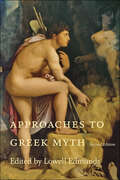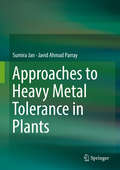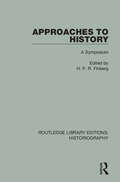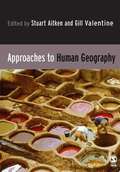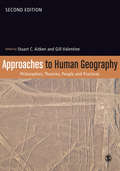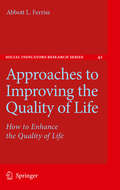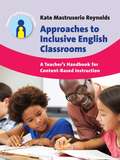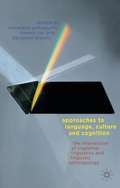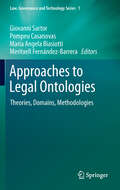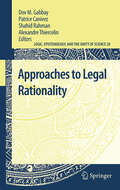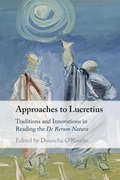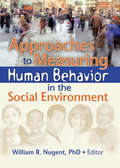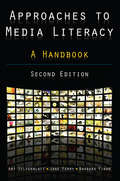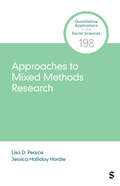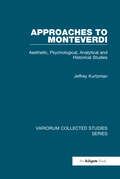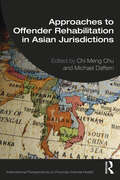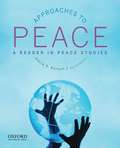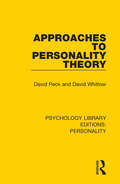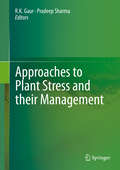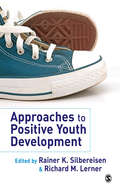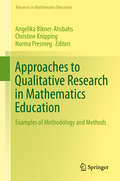- Table View
- List View
Approaches to Greek Myth
by Lowell Edmunds“A handy introduction to some of the more useful methodological approaches to and the previous scholarship on the subject of Greek myths.” —PhoenixSince the first edition of Approaches to Greek Myth was published in 1990, interest in Greek mythology has surged. There was no simple agreement on the subject of “myth” in classical antiquity, and there remains none today. Is myth a narrative or a performance? Can myth be separated from its context? What did myths mean to ancient Greeks and what do they mean today?Here, Lowell Edmunds brings together practitioners of eight of the most important contemporary approaches to the subject. Whether exploring myth from a historical, comparative, or theoretical perspective, each contributor lucidly describes a particular approach, applies it to one or more myths, and reflects on what the approach yields that others do not. Edmunds’s new general and chapter-level introductions recontextualize these essays and also touch on recent developments in scholarship in the interpretation of Greek myth.Contributors are Jordi Pàmias, on the reception of Greek myth through history; H. S. Versnel, on the intersections of myth and ritual; Carolina López-Ruiz, on the near Eastern contexts; Joseph Falaky Nagy, on Indo-European structure in Greek myth; William Hansen, on myth and folklore; Claude Calame, on the application of semiotic theory of narrative; Christiane Sourvinou-Inwood, on reading visual sources such as vase paintings; and Robert A. Segal, on psychoanalytic interpretations.“A valuable collection of eight essays . . . Edmunds’s book provides a convenient opportunity to grapple with the current methodologies used in the analysis of literature and myth.” —New England Classical Newsletter and Journal
Approaches to Heavy Metal Tolerance in Plants
by Sumira Jan Javid Ahmad ParrayThis book summarizes the development of highly tolerant cultivars via plant breeding, genomics, and proteomic approaches. This book could supplement data for budding researchers by providing extensive ongoing measures to improve the detoxification competence of appropriate species via wide range of plant improvement approaches. It also offers insights into heavy metal signalling,metal chelation by organic acids, amino acids, and phosphate derivatives, and illustrates other strategies that have been extensively investigated, such as genetic engineering, ecological improvement of the rhizosphere using mycorrhiza and chelator enhanced phytoremediation technology. This book could provide simple anthology for undergraduate and postgraduate students to understand fundamentals of heavy metal pollution in the environment. The book closes with a prelude to an inclusive study of biodiversity that could provide new biofilters for metal detoxification.
Approaches to History: A Symposium (Routledge Library Editions: Historiography)
by H. P. FinbergThe contributors to this volume, originally published in 1962, explain the raison d’être of their own specialism in history be it archaeology, political, local, economic or social history or historical geography.
Approaches to Human Geography
by Stuart Aitken Gill ValentineApproaches to Human Geography is the essential student primer on theory and practice in human geography. It is a systematic review of the key ideas and debates informing post-war geography, explaining how those ideas work in practice. In three sections, the text provides: · A comprehensive contexualising essay: Introducing Philosophies, People and Practices · Philosophies: written by the principal proponents, easily comprehensible accounts of: Positivistic Geographies; Humanism; Feminist Geographies; Marxism; Structuration Theory; Behavioral Geography; Realism; Post Structuralist Theories; Actor-Network Theory; and Post Colonialism · People: prominent geographers explain events that formed their ways of knowing; the section offers situated accounts of theory and practice by, for example: David Ley; Linda McDowell; and David Harvey · Practices: applied accounts of Quantification, Evidence and Positivism; Geographic Information Systems; Humanism; Geography, Political Activism, and Marxism; the Production of Feminist Geographies; Poststructuralist Theory; Environmental Inquiry in a Postcolonial World; Contested Geographies · Student Exercises and Glossary Avoiding jargon - while attentive to the rigor and complexity of the ideas that underlie geographic knowledge – the text is written for students who have not met philosophical or theoretical approaches before. This is a beginning guide to geographic research and practice. Comprehensive and accessible, it will be the core text for courses on Approaches to Human Geography; Philosophy and Geography; and the History of Geography; and a key resource for students beginning research projects.
Approaches to Human Geography: Philosophies, Theories, People and Practices
by Gill Valentine Professor Stuart C Aitken"The book covers some of the (traditionally) most obtuse and difficult-to-grasp philosophical ideas that have influenced geographers/geography. The fact that these are presented in an inclusive and accessible manner is a key strength. Many students have commented that the chapters they have read have encouraged them to read more in this field, which is fantastic from a lecturer's perspective." - Richard White, Sheffield Hallam University A new edition of the classic Approaches text for students, organised in three sections, which overviews and explains the history and philosophy of Human Geographies in all its applications by those who practise it: Section One - Philosophies: Positivist Geography / Humanism / Feminist Geographies / Marxisms / Structuration Theory / Human Animal / Realism / Postmodern Geographies/ Poststructuralist Theories / Actor-Network Theory, / Postcolonialism / Geohumanities / Technologies Section Two - People: Institutions and Cultures / Places and Contexts / Memories and Desires / Understanding Place / Personal and Political / Becoming a Geographer / Movement and Encounter / Spaces and Flows / Places as Thoughts Section Three - Practices: Mapping and Geovisualization / Quantification, Evidence, and Positivism / Geographic Information Systems / Humanism / Activism / Feminist Geographies / Poststructuralist Theories / Psychoanalysis / Environmental Inquiry / Contested Geographies and Culture Wars Fully updated throughout and with eight brand new chapters - this is the core text for modules on history, theory, and practice in Human Geography.
Approaches to Improving the Quality of Life: How to Enhance the Quality of Life (Social Indicators Research Series #42)
by Abbott L. FerrissAfter measuring the Quality of Life and identifying the deficiences in your community, what steps should you take to improve the Quality of Life? This volume reviews methods for improving the Quality of Life that are based upon improving each of the ten domains of the Quality of Life. Steps to improve health, means of reducing environmental toxins, orientation to bring about better self-concept and mental health, and so forth. In each such area, steps are set forth for eliminating undesirable and debilitating features of the domain. Social change comes about by the application of devised steps. The process has been called "telesis". It is the application of intelligent, well-tested interventions to bring about improvement. In some cases it may effect change quickly and others may require a continuing process of adjustment and change. As a handbook for community workers, the volume provides a framework for intervention that could lead to a better tomorrow.
Approaches to Inclusive English Classrooms
by Kate Mastruserio ReynoldsThis book provides educators with an accessible guide to best practices concerning content-based instruction (CBI) models and their use in English learner inclusive classrooms. The author effectively bridges the gap between theory and practice with a critical analysis of practical examples and diverse strategies for the inclusion of English learners into K-12 general education courses. The book also raises controversial questions regarding who is qualified to teach English learners and who is responsible for doing so, looking at the difficulties faced by both general educators and ESL teachers in inclusive classrooms. By providing a lens through which both ESL teachers and general educators are able to analyze, compare and contrast a range of widely-employed CBI methods, this book allows teachers to make informed decisions in their EL program development and work with English learners in K-12 schools.
Approaches to Language, Culture, and Cognition
by Masataka Yamaguchi Dennis Tay Benjamin BlountApproaches to Language, Culture and Cognition aims to bring cognitive linguistics and linguistic anthropology closer together, calling for further investigations of language and culture from cognitively-informed perspectives against the backdrop of the current trend of linguistic anthropology.
Approaches to Legal Ontologies: Theories, Domains, Methodologies (Law, Governance and Technology Series #1)
by Giovanni Sartor Mariangela Biasiotti Meritxell Fernández-Barrera Pompeu CasanovasThe book provides the reader with a unique source regarding the current theoretical landscape in legal ontology engineering as well as on foreseeable future trends for the definition of conceptual structures to enhance the automatic processing and retrieval of legal information in the Semantic Web framework. It will thus interest researchers in the domains of the SW, legal informatics, Artificial Intelligence and law, legal theory and legal philosophy, as well as developers of e-government applications based on the intelligent management of legal or public information to provide both back-office and front-office support.
Approaches to Legal Rationality (Logic, Epistemology, and the Unity of Science #20)
by Dov M. Gabbay Patrice Canivez Shahid Rahman Alexandre ThiercelinLegal theory, political sciences, sociology, philosophy, logic, artificial intelligence: there are many approaches to legal argumentation. Each of them provides specific insights into highly complex phenomena. Different disciplines, but also different traditions in disciplines (e.g. analytical and continental traditions in philosophy) find here a rare occasion to meet. The present book contains contributions, both historical and thematic, from leading researchers in several of the most important approaches to legal rationality. One of the main issues is the relation between logic and law: the way logic is actually used in law, but also the way logic can make law explicit. An outstanding group of philosophers, logicians and jurists try to meet this issue. The book is more than a collection of papers. However different their respective conceptual tools may be, the authors share a common conception: legal argumentation is a specific argumentation context.
Approaches to Lucretius: Traditions and Innovations in Reading the De Rerum Natura
by Donncha O’RourkeBoth in antiquity and ever since the Renaissance Lucretius' De Rerum Natura has been admired – and condemned – for its startling poetry, its evangelical faith in materialist causation, and its seductive advocacy of the Epicurean good life. Approaches to Lucretius assembles an international team of classicists and philosophers to take stock of a range of critical approaches to which this influential poem has given rise and which in turn have shaped its interpretation, including textual criticism, the text's strategies for engaging the reader with its author and his message, the 'atomology' that posits a correlation of the letters of the poem with the atoms of the universe, the literary and philosophical intertexts that mediate the poem, and the political and ideological questions that it raises. Thirteen essays take up a variety of positions within these traditions of interpretation, innovating within them and advancing beyond them in new directions.
Approaches to Measuring Human Behavior in the Social Environment
by William R. NugentMake the best use of measurement approaches that gauge social behaviorHere is a state-of-the-art examination of various approaches to measuring and assessing client functioning and specific aspects of clients&’ social environments. It examines numerous age groups and ethnic populations and makes use of cutting-edge methodologies in its examinations of measuring depression in children, measuring "the neighborhood" from a child&’s perspective, measuring and assessing family functioning, measuring spirituality, and measuring psychosocial problems in seriously mentally ill families. Helpful tables in each chapter make complex information easy to access and understand.Inside Approaches to Measuring Human Behavior in the Social Environment you&’ll find: a psychometric evaluation of the Structured Clinical Interview for DSM-IV Childhood Diagnoses (KID-SCID) (with 4 tables) a clinical/psychometric perspective on using self-rating scales for assessing severely mentally ill individuals (with a chapter appendix and 2 tables) vital information on assessing the influence of tradition upon Chinese elders in order to provide culturally sensitive services (with 4 tables) a report on the psychometric properties of the Rap Music Attitude and Perception (RAP) Scale, an instrument designed to measure attitudes toward and perceptions of rap music (with 6 tables) a report on the assessment of self-esteem in people with severe mental illness (with 2 figures and 4 tables) a qualitative study of fourth and fifth graders&’ views of the neighborhoods they live in (with 5 figures and 2 tables) an NIMH- and USDHHS-funded study examining the reliability and validity of the Preschool Symptom Self-Report (PRESS) which measures depression in maltreated young children (with 4 tables) a study of advances designed to improve the reliability/validity of the North Carolina Family Assessment Scale (NCFAS) as it relates to placement and the prediction of future placement within the context of Intensive Family Preservation Services (IFPS) (with 1 figure and 7 tables) conformatory factor analyses of the Secondary Traumatic Stress Scale (STSS) (with 3 figures and 4 tables) a report illustrating the development and empirical testing of the Spiritual Strategies Scale (SSS)-a measure of spiritual supports used by older adults in managing challenges in their lives (with 4 tables) an examination of the validity of college students&’ responses to the Scale for the Identification of Acquaintance Rape Attitudes (SIARA), a measure designed to assess attitudes believed to be supportive of sexual violence within dating relationships (with 3 figures and 5 tables)Approaches to Measuring Human Behavior in the Social Environment is vital reading for master&’s and PhD level social workers, psychologists, counselors, marriage and family therapists, psychiatrists, and researchers in these fields.
Approaches to Media Literacy: A Handbook
by Art Silverblatt Jane Ferry Barbara FinanCompletely updated, with current examples and new coverage of digital media, this popular handbook provides a range of qualitative approaches that enable students to effectively decipher information conveyed through the channels of mass communication - photography, film, radio, television, and interactive media. It aim is to help students develop critical thinking skills and strategies with regard to what media to use and how to interpret the information that they receive. The techniques include ideological, autobiographical, nonverbal, and mythic approaches. An Instructor's Manual is available to professors who adopt this new edition.
Approaches to Mixed Methods Research (Quantitative Applications in the Social Sciences)
by Lisa D. Pearce Jessica Halliday HardieApproaches to Mixed Methods Research focuses on the choices social scientists make when designing a study that mixes quantitative and qualitative data. Authors Lisa D. Pearce and Jessica Halliday Hardie explore ways to weave together strands of research using qualitative and quantitative data to speak to and enhance each other; a strand being a series of steps involved in collecting and analyzing a single type of data. The result, they show, is a more holistic body of evidence that emerges, and they illustrate this with examples from a wide range of studies from the United States and other countries.
Approaches to Mixed Methods Research (Quantitative Applications in the Social Sciences)
by Lisa D. Pearce Jessica Halliday HardieApproaches to Mixed Methods Research focuses on the choices social scientists make when designing a study that mixes quantitative and qualitative data. Authors Lisa D. Pearce and Jessica Halliday Hardie explore ways to weave together strands of research using qualitative and quantitative data to speak to and enhance each other; a strand being a series of steps involved in collecting and analyzing a single type of data. The result, they show, is a more holistic body of evidence that emerges, and they illustrate this with examples from a wide range of studies from the United States and other countries.
Approaches to Monteverdi: Aesthetic, Psychological, Analytical and Historical Studies (Variorum Collected Studies)
by Jeffrey KurtzmanThis volume gathers together twelve essays on the composer’s music, reflecting the author's interests in aesthetic and psychological issues, the sacred works, methods of structural analysis, and the problems of making critical editions. The opera Orfeo and two madrigals from Monteverdi's Book Eight are the subject of aesthetic and psychological investigation, especially from the perspective of Michel Foucault's The Order of Things and the psychology of C.J. Jung, all supported by musical analysis. Two essays analyze in detail the structural principles of the psalms Laetatus sum from the 1610 Vespers and the first Dixit Dominus from the Sevla Morale e spirituale of 1641. Two others re-examine the story of Monteverdi's Mass of Thanksgiving and consider the question of what sacred music Monteverdi actually or likely wrote but is now lost. The final essay critiques and compares the methodology and problems of the Malipiero and Cremona editions of Monteverdi's Opera Omnia. All but one of these essays were originally published over a time span of twenty years in journals, conference reports, Festschriften, and as book chapters. The majority of them were not widely distributed or readily available until now. The essay on the Malipiero and Cremona editions appears here for the first time.
Approaches to Offender Rehabilitation in Asian Jurisdictions (International Perspectives on Forensic Mental Health)
by Michael Daffern Chi Meng ChuThis book aims to understand how Asian jurisdictions conceptualise rehabilitation within both the correctional and forensic mental health sectors.Little has been written about rehabilitation practices for people in criminal justice and forensic mental health services in Asia. Although there is some recognition of the need to develop and/or adjust rehabilitation practices for non-white/non-western peoples in Western jurisdictions, the extent to which Western-derived practices have been considered, adjusted, or adopted in Asian countries is not well known. This book includes contributions from an international team who explore the ways in which history, culture, religion, and resources impact how rehabilitation is conceptualised and offered in multiple Asian countries. It aims to provide an understanding of the relative merits of contemporary Western practices across different Asian countries and consider how these practices have been adopted and adapted within correctional and forensic mental health sectors.This book is essential for administrators who are developing rehabilitation strategies and for practitioners working with people who have a history of offending behaviour.
Approaches to Peace: A Reader in Peace Studies
by David P. Barash"For those endeavoring to approach peace, there is no shortage of challenges, practical as well as intellectual. Fortunately, there is also no shortage of inspiration and insight. "--From the preface Approaches to Peace: A Reader in Peace Studies, Second Edition, provides a unique and interdisciplinary sampling of key articles and short literary selections focusing on the diverse facets of peace and conflict studies. Featuring both classic and contemporary work, it enables students to read highly influential articles while also introducing them to the most current perspectives in the field. Timeless classics from Leo Tolstoy, the Bhagavad Gita, Martin Luther King, Jr. , Gandhi, and Henry David Thoreau are included alongside contemporary pieces by Johan Galtung, Betty Reardon, and many others. Updated to address current concerns, the second edition incorporates seventeen new articles, including selections from Al Gore on climate change, Jeffrey Sachs on Third World economies, and Desmond Tutu on reconciliation. A new chapter on terrorism offers work from Eqbal Ahmad, Richard Falk, Samuel Huntington, and others. Ideal on its own as a foundation text in any introductory peace studies course, Approaches to Peace, Second Edition, is also compact enough to use as a supplement with more specialized readings. Each selection is prefaced by a short introduction highlighting the author's background, the work's historical context, and the selection's significance in terms of the "big picture. " Study questions and a list of suggested readings at the end of each selection also provide useful resources for students.
Approaches to Peace: A Reader in Peace Studies
by David P. BarashApproaches to Peace: A Reader in Peace Studies, Fourth Edition, provides a unique and interdisciplinary sampling of key articles focusing on the diverse facets of peace and conflict studies. Featuring both classic and contemporary work, it enables students to read highly influential articles while also introducing them to the most current perspectives in the field. Timeless classics from Leo Tolstoy, Martin Luther King, Jr., Gandhi, and Henry David Thoreau are included alongside contemporary pieces by illustrious contributors including Noam Chomsky, bell hooks, Vandana Shiva, and Pope Francis.
Approaches to Personality Theory (Psychology Library Editions: Personality)
by David Peck David WhitlowOriginally published in 1975, this book reviews the major personality theories influential at the time, including those of Freud, Kelly, Cattell, and Eysenck, and presents the main assessment techniques associated with them. It also discusses their application in such fields as abnormal psychology, diagnosis, psychotherapy, education and criminology. The authors find none of the theories completely satisfactory, but pinpoint important successes and suggest a promising new approach.
Approaches to Plant Stress and their Management
by R. K. Gaur Pradeep SharmaPlant stresses are serious threats to the sustainability of crop yields accounting for more crop productivity losses than any other factor in rainfed agriculture. Post-harvest losses mean surplus crops do not reach market, affecting the livelihoods of farming families, and too often these families are left with no other option than to eat contaminated stored food. These constraints impact the food security of these farming families as well as the communities and countries in which they live. This book is the demonstration of a clear synergistic effect of stresses, an effect that was unexpectedly as important as either stress applied alone. This book will add to our current knowledge of abiotic stress response in plants and will provide the groundwork necessary to build future strategies for crop enhancement. The fundamental principles that underpin all biotechnology are explained and a full range of examples discussed to show how these principles are applied; from starting substrate to final product. It will be beneficial to both plant breeders and molecular biologists, because it combines the topics of physiology, tolerance genes, and breeding methods. When these topics are presented together, it is easy to compare all aspects of tolerance mechanisms and breeding methods for abiotic stresses. These comparisons are useful to understand which pathways or which genes are important for rendering more tolerance to a certain abiotic stress, and to bring forward new ideas for improving the tolerance. Features *Cover both plant biotic and abiotic stresses *Important factors in managing crops for water stress conditions *Substantially increase the sustainable productivity of smallholder farmers in developing countries *Genetic and biochemical approaches - if those approaches constitute a substantial improvement on current practices.
Approaches to Positive Youth Development
by Dr Rainer K. Silbereisen Dr Richard M. LernerScientific research and science-guided practice based on the promotion of an individual's strengths constitutes a radical shift in a new and growing area of study within the field of human development. Its trademark term is `positive youth development'. This approach to human development is based on the idea that, in addition to preventing problems, science and practice should promote the development of competencies, skills, and motivation in order to enhance individuals' developmental pathways. Approaches to Positive Youth Development, is based on this concept and brings together authors from across Europe and America who are leaders in their respective fields. The main focus of the book, beyond a clarification of the paradigmatic foundations, concerns the major contexts of adolescents and young adults, namely, neighbourhoods and leisure locales, school and family, and the major themes of healthy psychosocial development, namely, competences and knowledge, prosocial behaviour, transcending problems of delinquency, civic engagement, identity, agency, and spirituality.
Approaches to Qualitative Research in Mathematics Education: Examples of Methodology and Methods (Advances in Mathematics Education)
by Norma Presmeg Angelika Bikner-Ahsbahs Christine KnippingThis volume documents a range of qualitative research approaches emerged within mathematics education over the last three decades, whilst at the same time revealing their underlying methodologies. Continuing the discussion as begun in the two 2003 ZDM issues dedicated to qualitative empirical methods, this book presents astate of the art overview on qualitative research in mathematics education and beyond. The structure of the book allows the reader to use it as an actual guide for the selection of an appropriate methodology, on a basis of both theoretical depth and practical implications. The methods and examples illustrate how different methodologies come to life when applied to a specific question in a specific context. Many of the methodologies described are also applicable outside mathematics education, but the examples provided are chosen so as to situate the approach in a mathematical context.
Approaches to Reducing the Use of Forced or Child Labor: Summary of a Workshop on Assessing Practice
by National Research Council of the National AcademiesGlobally, child labor and forced labor are widespread and complex problems. They are conceptually different phenomena, requiring different policy responses, though they may also overlap in practice. The Trafficking Victims Protection Act of 2000 (TVPA) was designed to reduce the use of child and forced labor in the production of goods consumed in the United States. The Act was reauthorized in 2003, 2005, and 2008. In response to provisions of TVPA, the the Bureau of International Labor Affairs requested that the National Research Council organize a two-day workshop. The workshop, summarized in this volume, discusses methods for identifying and organizing a standard set of practices that will reduce the likelihood that persons will use forced labor or child labor to produce goods, with a focus on business and governmental practices.
Approaches to Road Safety: Evolution, Challenges, and Emerging Technologies
by Peter SweatmanRoad transport is on a constant course to maintain and improve driving safety in what is a complex process involving multiple forms of risk. It is time for embracing system technologies that give more meaning to the philosophical phrase "safe system" and Approaches to Road Safety: Evolution, Challenges, and Emerging Technologies makes the case for the adoption of safer systems in road transport industries through the embracing of technological paradigms, system attributes and more clearly articulated values. This book offers an account of the professional road safety enterprise in action in the United States, Australia and elsewhere, covering the contributions of Haddon in the 1960s, the creation of NHTSA, the development of the science of human factors, the enduring philosophy of countermeasures to motor vehicle crashes, motor vehicle safety regulations, occupant restraint and protection, collision avoidance, road and traffic design, driver assistance systems, pre-crash scenarios and vulnerable road users. It addresses the harm caused by roadway collisions, including the strategies of Vision Zero and the safe system. It places the enterprise of road safety within the greater system of road vehicle transportation. It also covers ethical preoccupations besides safety, including the rise of sustainability and its operational challenges, including uneven professionalism. Automation and the rise of driverless vehicles are discussed with these being described as a useful long-term change-agent in transportation systems. The important paradigm of connected vehicles and infrastructure is also described, along with the under-utilized science of human factors. The reader is exposed to a nuanced look at the world of road transport safety through its beginnings to the modern age of automation, allowing them to have a contextualized view of the subject area.Offering valuable insights, this book will appeal to professionals in the fields of safety, human factors, the automotive industry, traffic control, vehicle standards and regulations, transportation systems and road safety policy.
